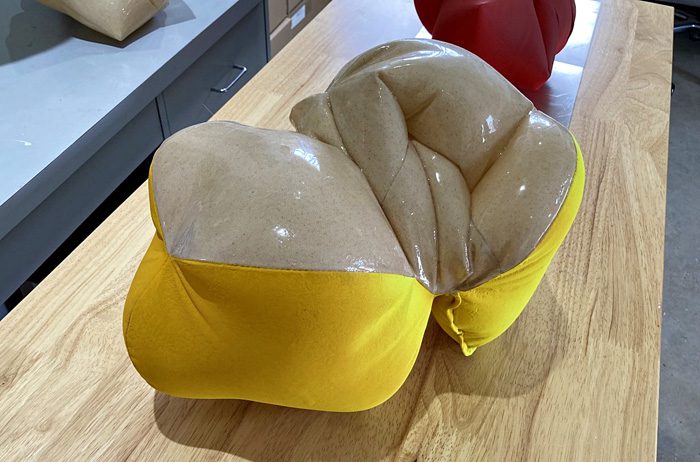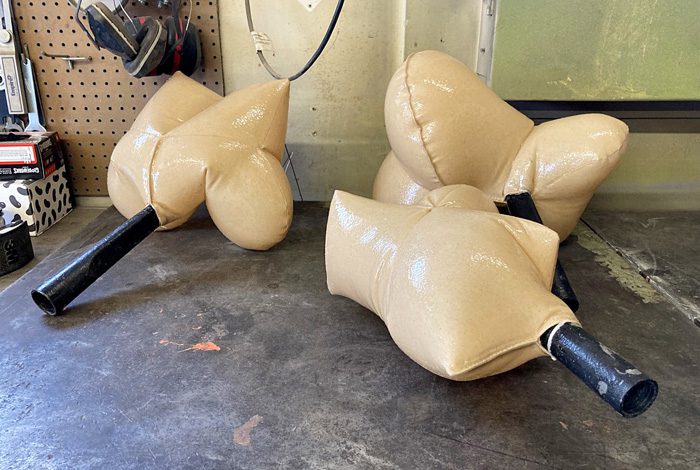New Mexico artist Jeremy Thomas uses inflation methods to create three-dimensional works of steel and canvas that explore air as a medium for artistic expression.
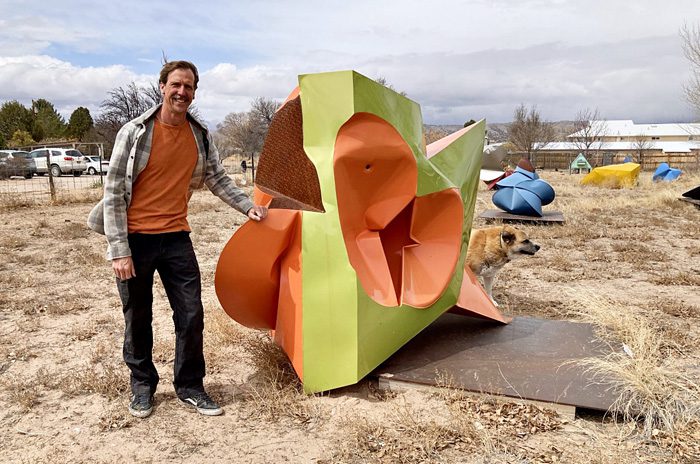
Creased and folded steel sculptures of various shapes and sizes adorn the front lot of sculptor Jeremy Thomas’s property. The artworks punctuate an earth-toned landscape with bright bursts of color and offer a refreshingly strange scene to anyone who drives down the otherwise innocuous, rural road that passes by his house.
Sitting in his home studio in Española, New Mexico, the artist says, “Initially, I thought of myself as a metalworker,” but over the years, he’s come to realize that “my material and medium is air.” Not only does he consider himself an air-worker, but he also distances himself from the notion of building the objects he creates. “They’re not made, so much as they’re grown—a growing process as opposed to a fabrication process,” he explains.
To associate his objects with something as invisible as air and as natural as a grown organism appears contradictory, but speaking about his practice, the artist—represented regionally by Charlotte Jackson Fine Art in Santa Fe and Bentley Gallery in Phoenix—explains his position.
Thomas says, “I’m focused on an object that air manipulates, injecting air into geometric” shapes. Part of his identification as an air-worker resulted from “realizing the dynamics of air and how it works. What I play with is atmospheric pressure. It’s what holds us where we’re at; it’s what holds everything together.”
As he more thoroughly grasped his primary medium of air, Thomas radically altered his creation process. “When I first started [inflating steel], I used a furnace for blacksmithing and a forge where I would place the steel piece, heating it to a little over 2,000 degrees, then inject air into it” while the object was still hot. In order to accomplish this task, he would “weld tubing into the piece, acting almost like [a glass blower’s] pontil.”
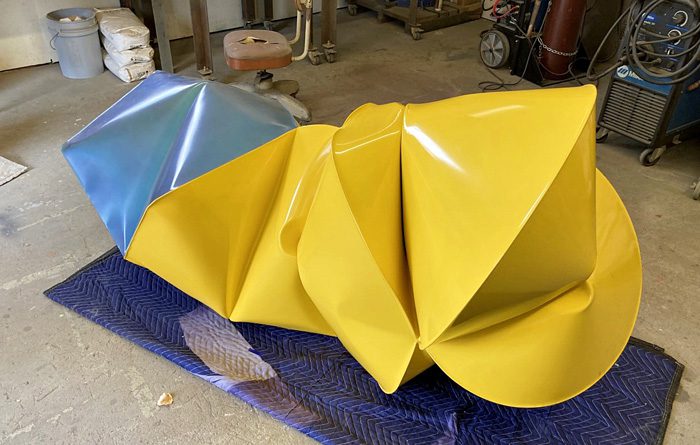
“My biggest forge was a four-foot cube on the inside. I had to use a vast quantity of fuel to heat it up.” Thomas, wanting to decrease his carbon footprint, coupled with his increased knowledge of air, realized that “if I used the right thickness of steel, the material itself could operate as a fulcrum and leverage the work as it inflated. That allowed me to break away from the four-foot cube that I was stuck inside of and change the dynamic of the shapes and forms I was working on, as well as their scale.”
Experimenting with atmospheric pressure allowed the artist to shift from a hot practice to a cool practice. “As long as I increase the pressure on the interior of the form greater than the atmospheric pressure, it’s going to move outward,” Thomas says. “I do that subtlety, very slowly. I use multiple gauges, watch what’s going on, and am aware of the stress points in each object. It’s something I’ve developed over time—learning the sensitivity” of air and steel’s interaction. “It’s really a dialogue of the form, the shape, and me. Back and forth, back and forth. Inflating a big piece can take hours.”
Through this dialogue between himself, atmospheric pressure, and steel, the pieces “evolve, they roll, they wrinkle. They have their own history,” Thomas says, “and the inflation is a record of time. Of place. Every crease that it makes is retained in the steel. And as the sculptures expand, they change and contain something more. They are containers, but they’re not containers—capturing the essence of [air] for a particular moment. But air is so transitory: it’s here, then it’s gone.”
As for the broader significance of his inflated, steel sculptures and their interaction with the air around us, Thomas notes, “A human breathes 22,000 times a day. [For the most part], we’re completely unconscious of the fact that we’re taking in air and exhaling it out. What are you absorbing? What are you sharing?
“[Air] is a shared medium that we all have; it’s a commonality,” he continues. “It also suggests ideas and things that are less concrete, more metaphysical. I try not to pin those things down; you have to allow every viewer to approach [an object] and come to their own conclusions, especially when you’re dealing with something that’s so universal and we all use to survive.”
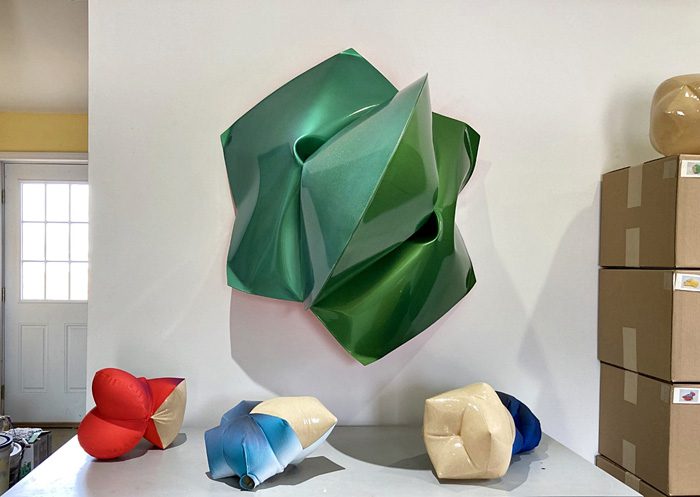
While Thomas’s investment in the practice of growing air-based, steel-composed objects remains strong, recent events set him on a new, material trajectory. “When the pandemic hit, it was such a worrisome time. I felt that I needed to be both cleaner and lighter. So I started making pieces out of hemp base on shapes derived from lamps and lanterns.”
Those experiments with hemp transformed into a series of canvas-based objects. “For these cloth pieces,” the artist says, “I coat them in zero-VOC [Volatile Organic Compounds] resin, inflate the piece, and then manipulate them with my hands to get a fold or crease where I really want it. It’s a wet process, so [the object] needs to be inflated and cured within a pretty quick timeframe.”
The canvas objects allow Thomas to “express something that steel doesn’t. There’s an immediacy to fabric that I can’t get with steel. Forms I cannot attain with steel. Steel has its limitations: it only moves in certain directions or ways. Fabric allows me to get shapes that I’ve always wanted to get with steel but couldn’t.”
While Thomas notes that “every time you use a specific material, you’re bringing a particular history with it,” he also finds resonances between steel and canvas. “As I sew canvas, I realize that it’s very similar to TIG [Tungsten Inert Gas] welding. TIG welding is dab after dab—you have to be right there, present. When you’re sewing, it’s the same. Every stitch—you have to be present for each one. Right. There.” Indeed, as the artist notes, “there can be a dialogue between materials” as well.
As for the future of both his steel and canvas air-based objects, Thomas intends to “follow the work. The work will tell me where to go. I don’t necessarily know what the next step is going to be. I know I’m going to keep growing constructs. That’s what I do. I have to.”
